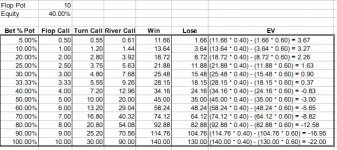Chapter 4 Summary.
(No example this time because the concepts presented in the chapter are very simple and rather well known to everybody. Instead, I made the summary a bit longer and added some stuff not mentioned in the book  )
1. A Game consists of:
a)
)
1. A Game consists of:
a) 2+ players
b) 1+ player has choices (strategy)
(in Poker every player has a strategy whereas in Blackjack a Dealer (who is considered a player) does not have any choices - he just has to follow a specifc set of rules).
c) Set of outcomes for each player (eg: $won/lost)
d) Outcomes depend on players' choices
2. Strategy - a complete specification of a player's actions.
In No-Limit Holdem that would be a complete specification of actions for every hand in range on every board run-out (every Flop, every Turn and River), opponents' actions, bet/stack sizes. Because this results in an enourmous game tree, we do the following things:
a) we use the term "strategy" a little more loosely (some people describe their strategy like:
"I play tight and I bet good hands" <- now, how loose is that!

).
b) we approximate/simplify lots of things through:
- eliminating very rare scenarios: if Villain has a range of 50% hands, you should not worry and develop a separate strategy for the times he flopped quads because it happens so rarely.
- grouping stuff together: instead of looking at each possible River card, we can divide them into specific, board changing groups such as: blanks, flush cards, overcards, Aces etc and develop our strategies for each of those groups; grouping hands in our/opponents' ranges works as well (maybe we are playing all of our Axs in a same way in a particular spot - why not treat them as "one"); same goes with grouping flop types (A-high, monotone, paired etc).
- reducing the amount of bs based on common sense/population tendencies: there is no need to look at every possible bet size with an increment of 1BB. Just look at common used sizings: 50%, 75% and pot size etc; check-raising on the River while leaving yourself 3BBs in the stack and then folding to a "re-shove" is not a logical and common line.
- reducing the amount of possible actions: various half/one/two street toy-games, lowering stack sizes etc.
3. Maximally exploitive strategy - a strategy with the highest EV against opponent's strategy.
(so this is quite a new type of thinking for lots of people; we are used to 'hand vs hand' or 'hand vs range' thinking/exploitation but here we are talking about strategy vs strategy exploitation. How awesome is that? Take a look at this article in your free time Levels of Randomness: Beyond G-Bucks)
Two steps to developing a maximally exploitive strategy:
1. Identify Villain's strategy - how he plays his ranges (HUD stats, population tendencies/common lines, experience, observation (eg: showdowns, how he plays his draws/made hands, is he cbetting polarized etc)).
2. Compute the most profitable response (math).
4. Draws vs made hands.
* Poker is not static - value of hands do change from street to street.
* Draw - a "worse" hand that needs to improve (outs) to be the best.
* A hand is said to be a favourite if it has the most equity in the pot (underdog - has the least amount of equity). Draws can be favourites.
In a made hand vs draw situations:
* The made hand usually bets.
* The draw usually calls if it has positive equity in the pot.
5. Pot odds and Implied odds.
Pot odds - ratio of the current size of the pot (
Reward) to the cost of a potential call (
Risk).
It's important to always think in terms of Risk:Reward. This equation will be constantly used in various toy games and real
poker hands/scenarios:
Risk:Reward => Risk / (Risk + Reward)
It does not matter if you're deciding whether to make a call or a bluff, this equation is the way to go:
1. You 3-bet bluff to 9BB BTN vs CO 3BB open. You're risking 9BB (
Risk) to win 0.5BB + 1BB + 3BB = 4.5BB (
Reward) so it has to work
more than: 9 / (9 + 4.5) =
66% of the time.
2. You cbet half the pot P. You're risking 0.5P to win P so it has to work: 0.5P / (0.5P + P) =
33% of the time (aka Villain's FCB >= 33%).
3. Someone bets $5 into a pot of $7. You have to risk $5 to win a pot of $5 + $7 = $12 so you have to win at least: $5 / ($12 + $5) =
29% of time.
Important facts about pot odds:
a) when drawing, always take into consideration chances of making the best hand on the next street unless you know you will get a free card on follow-up streets (simply put: when you have a draw on the flop, you should compare
pot odds with your odds of making the hand
on the Turn not on the Turn OR on the River).
b) raising with a draw to "get a correct price on drawing" (it probably applies mostly to Limit games) does not work - it's actually stupid because you're just putting more money into the pot as an underdog.
So pot odds basically assume that when the draw completes, no additional money goes into the pot.
Implied Odds, on the other hand, take into consideration the money which is currently in the pot as well as additional money which might go into the pot on future streets when the draw completes.
Things that affect Implied Odds (IO):
a) big stack sizes (high IO).
b) tight players who only put money into the pot when they have strong hands (high IO), tight/weak players who fold to any postflop resistance (because
"Turn/River raises are always the nuts at uStakes"; low IO).
c) aggressive players/maniacs (high IO); aggressive/loose preflop players (low IO); passive/loose players (also low IO).
d) board texture - the more draw heavy/scary/"obvious" board the lower the IO.
Beware of
Reverse Implied Odds which describe the amount of money you will lose when you actually make your hand eg: you are drawing to a flush but the flush card also paires the board giving someone else a FH.
6. Reasons for betting: Value/Protection/Bluff (mutually inclusive).
They have been already described in more detail here:
Reasons for Betting
)










